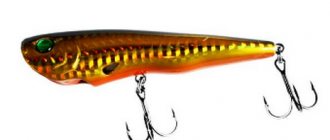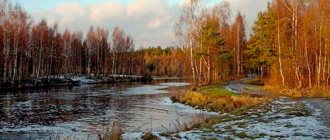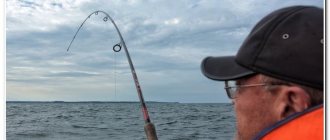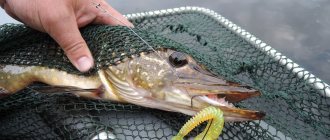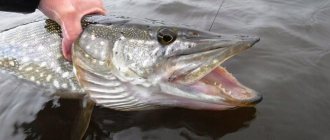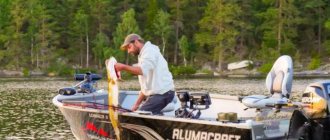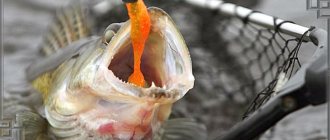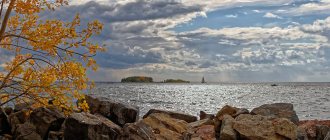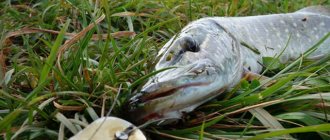Pike is one of the most desirable fish that every angler dreams of seeing in his catch. The hunt for this legendary predator is overgrown with a bunch of legends and tales that fishermen listen to with pleasure and pass on from generation to generation, enjoying the anticipation of meeting a toothy trophy. But in any fairy tale there is a grain of truth on which events are based, and pike fishing in this sense is no different from other fictional stories in the reality of its underlying basis.
What does the bite depend on?
You need to take this predator's catch seriously. After all, this fish is very capricious, and an angler who does not know how to fish for pike, in most cases, is left without a catch. The pike bite depends on a lot of different factors, which should be correctly compared and analyzed when choosing the right fishing time.
Important! The success of a fishing strategy is influenced by atmospheric pressure, water and air temperature, the presence of precipitation, wind direction and strength, time of day and season. More subtle factors are the phases of the moon and the geomagnetic environment.
We will consider the influence of all these factors on the bite in more detail throughout the article.
Pike lures for spinning fishing
The variety of pike baits is clearly ahead of all other types of artificial bait that spinning anglers hunt for other freshwater predators. But the possibility of using bait requires not only knowledge of how to choose the right spinning rod, but also forces the angler to master a new technique of retrieving in different fishing conditions. And a spinning player who has the skills to work with various types of baits, regardless of the characteristics of the reservoirs, will be able to effectively fish for pike from the shore and boat, only by manipulating the baits. Further in the course of the article, we will characterize the most famous types of pike artificial baits, which are familiar to every person who is more or less familiar with spinning fishing.
Turntables and oscillators
The classics of pike fishing are spinners, which are produced in two types, oscillating and rotating. These baits do not require animation and work on uniform retrieves, which can be carried out at different paces, and also alternate with periodic stops. Oscillating spoon-shaped lures operate with wide stroke amplitudes, sparkling in the water and thereby arousing the interest of a predator. Rotating lures lure fish due to the shiny petal making circular movements around the rod, which is wound up by the play of the water resistance at the moment of winding the cord. Nozzles are made of metals and various alloys, painted in various promising colors.
Twisters and vibrotails
Twisters and vibrating tails are silicone attachments that are used in conjunction with weights and hooks of various weights and sizes. Lures imitate the movements of live fish, thereby tempting a predator to attack. The main use of this type of bait is jig fishing for pike. The bait material is often equipped with the introduction of strong attractants into the body, the so-called edible rubber, for more effective attraction of fish. The technique of catching pike with a spinning jig involves performing stepwise retrieves with pauses and the bait falling to the bottom.
Wobblers
Wobblers are products made of plastic or wood, imitating the body of a real fish in their shape, equipped with hooks and fastening elements to the tackle cord. The working blade of the wobbler sets the play of the nozzle, bringing it to a certain water horizon and providing amplitudes of stroke and vibration. The products are distinguished by their ability to play spontaneously, cranks, fetas and some types of minnows, but most wobblers require active animation on the part of the angler. This type of fishing is called twitching; this is when the spinning angler uses a jerk retrieve, winding up a loose cord during pauses. Varieties of wobblers, jerkbaits and ratlins, do not have a blade and work purely on wiring. By varying the size and type of retrieve, jerkbaits allow you to catch large pike.
Spinnerbaits
A spinnerbait is a combination bait that allows you to successfully catch pike on a spinning rod in the summer in conditions of a reservoir heavily overgrown with aquatic vegetation. The nozzle combination consists of silicone and a metal petal.
Important! The design of the product reduces the possibility of snagging, which makes its passage through thickets more efficient.
The silicone body with all sorts of worm and plumage imitations lures the predator, creating volume and natural movement of the object. The rotation and glare of the petal attracts the predator with sound vibration and visual distortions.
Bite at different times of the year
The best time to catch pike is a controversial concept. The cyclical activity of fish can occur in any season of the year. In most cases, these events do not find exact reasons explaining such actions of the fish, but nevertheless, during the long confrontation between man and pike, some patterns emerged.
When to catch pike in the fall
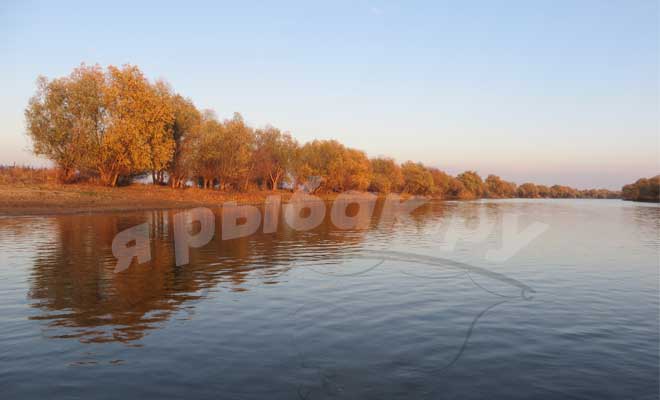
Autumn among fishermen is considered the pike season . At this time, the catfish is activated, preparing for the winter season, when it is necessary to have enough energy to survive in sub-ice conditions and at the same time prepare for spring spawning. In September, as the water gets colder, they begin to actively catch pike with a spinning rod, using a variety of artificial baits. At this time, the fish becomes less cautious and timid. The fry chases or, as fishermen say, washes up in the shallows, where they are discovered by this activity.
In October the bite increases. Now the predator reacts to any movements, rushing towards an actively behaving object. The golden age of circles and girders with live bait has arrived, and spinning fishing continues no less successfully.
November, during the period of the beginning of freeze-up, becomes the peak of pike bite activity. Now you can even put up rigs with dead fish, the predator takes them from the very bottom. The hunger of the first ice does not subside for a whole week from its beginning. With stable ice cover, it is already possible to catch pike with over-ice stakes, as well as with a spinner, casting a spinner directly from the ice. Thus, you can catch pike in the fall, depending on weather conditions, both in open water and from ice.
Winter
Winter is an ambiguous and most unpredictable time for hunting predators. December is characterized by stable and good bite. They fish with stakes from the ice, using various live baits, and also use traps with dead bait.
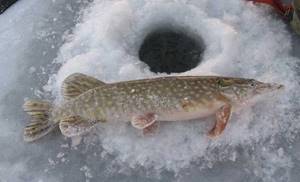
January is the complete opposite of the first winter month, the so-called deep winter. The fish are crushed by ice and low oxygen concentration in the water. At the same time, it loses activity, stops feeding for a long time and, accordingly, stops pecking at all. The probability of bites is reduced many times over. They try to fish with live bait at this time, selecting the most active species of fish such as gudgeon or bindweed.
In February, with increasing daylight hours, pike become more active and can be caught using spoons, ratlins and balancers. Under-ice bets continue to be among the fishing favorites, outpacing the number of fish coming out to lure.
Spring
Spring, as in the case of pike fishing in autumn, provides a chance to fish from ice and open water, and sometimes even combine these opportunities. March activates the predator to the limit. The fish gain weight before spawning. It can be caught with both live bait and artificial bait. It comes out from the depths to the shallows, to open areas of water, in search of sleepy white fish.

April, after the ice melts, is not as productive as the previous month. Firstly, the fish go to spawn and can only feed occasionally, and secondly, turbid water worsens fishing conditions, and live bait gives way to artificial baits with noise effects.
May is not uniform in the intensity of the bite. The pike is sick, changes teeth and feeds very poorly. Reacts where small artificial bait is used, capable of severe irritation by vibration and small tremors. This is the time to catch pike with spinners!
Summer
It is difficult to catch pike in the summer without knowing the reservoir and especially where it permanently stops. The fish moves through the reservoir weakly, prefers to stand in ambush, waiting for prey. In June, as the water warms up, the bite shifts in time to morning dawns and evening twilight. Spinning fishing is becoming promising. The use of wobblers and silicone baits is a priority.
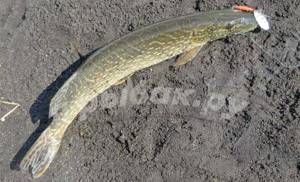
July, with its heat, is not such a promising month. The predator is lethargic and stays near springs and in shaded places. They begin to fish with live bait. August radically changes the predator. The toothed one is more aggressive and willingly takes oscillating spoons and large wobblers. The second half of August is comparable to the scenario that pike plays out in the fall. Fishing methods are also identical to the autumn version.
What to remember when hunting at night?
The best results are obtained by fishing for pike at night with a spinning rod in the fall, when the evening time is significantly extended. At this time, fishing is most effective from 1-5 am. But, in general, it is not necessary to catch pike at night in the fall; this can be done in another season. Hunting is especially effective in the warm season, when it is too hot during the day, the pike only gathers for prey at night, as it rests in the morning.
What's the best way to fish? Of course, the best option is hunting from the shore, since fishing on a boat is not an option in this case. The water vehicle will create additional noise, which the pike really doesn’t like, and it won’t even swim up to you at night. Due to the fact that all types of fish are resting and sleeping at this time, the pike will simply get scared.
Fishing for pike at night with a spinning rod should be carried out completely silently, as carefully and quietly as possible. In addition, you should be prepared for the fact that in case of a bite you will need to fish out the predator, which is why the other inhabitants will be scared. Therefore, as soon as you get one pike, be prepared to wait a few minutes until the fish calms down and goes hunting again.
- Attention! To continue active fishing after fishing in one place, you can either wait a little or move to another area of the reservoir where the fish have not yet seen you.
In addition, you need to take care of gear, lures and bait.
Conditions for the best bite
Regardless of the time of year, let's consider when it is better to catch pike under other factors. Stable pressure in the range of 730-745 mmHg improves bite. Art. within a couple of days. Winds from the south, southwest and west are always beneficial. The wind force is not higher than average, up to six meters per second - what is needed to create ripples and small waves without interfering with the comfort of fishing. For freeze-up, the wind of such parameters and direction is no less relevant.
Light rain is not an obstacle to biting, but precipitation in winter impairs the activity of fish. Fog also does not promise good fishing. Partly cloudy or cloudy weather is the most suitable option for pike fishing. Nuances that affect the intensity of the bite may be a deterioration in the geomagnetic situation. Strong magnetic storms negatively affect the bite, which must be taken into account when planning your trip. Based on the lunar calendar, it is preferable to plan fishing in the second and fourth quarters of the month. It has been noted that the fish are more active at this time.

Based on the time of day, we can note a high degree of bites in the early morning and evening, just before sunset. Sometimes there are intense fish outcrops in the reservoir during the day, at lunchtime. This pattern of bite intensity and temporary exits is inherent in each body of water, but with individual characteristics. This schedule of bites can be traced from year to year, which is especially clearly visible during the winter fishing period, and seasoned pike fish, who thoroughly know the reservoir, will be able, with a difference of up to half an hour, to predict the probability of bites without the slightest error, analyzing the relationship between weather conditions and other factors listed above.
Spring pike fishing with spinning rod. Peculiarities
When catching predators in the spring, you need to take into account certain points, which cannot be said about summer or autumn fishing.
- It is best to fish in shallow water - the fish prefers to live in places with standing water, where the depth does not exceed 1.5 meters.
- It is recommended to use small-sized baits whose retrieve speed is low. The predator at this time is still weak after spawning and will not go after large prey, which, in addition, also moves quickly.
- In some regions there is a spawning ban on catching pike in the spring.
Fishing for pike in early spring with a spinning rod
As mentioned above, in early spring in some regions it is prohibited to catch pike by any means (including spinning). In addition, if the harsh winter is behind us, there is still ice in many bodies of water. So you should postpone your fishing trip.
If there is no spawning ban, and all the ice has disappeared, then it is better to hunt pike in small rivers and creeks, as well as at the mouths of streams that flow into lakes.
In March, there is very changeable air pressure and temperature, so it is unknown when a great bite will overtake you - in sunny or cloudy weather. The best time to fish this month is morning and evening.
During the pre-spawning period, pike attacks any bait, even the most primitive ones. Therefore, spinners have a chance of a good catch.
Pike on a spinning rod in April
In April, pike usually bite poorly and are caught using spinning rods. The fish is either in the process of spawning, or has just finished it, and therefore is “sick.” In addition, April is characterized by floods, when pike stand in the coastal zone, among the reeds.
If during this period the predator goes out hunting, it is only in shallow water, where it can profit from small fish. There is no point in looking for it at depth at this time.
Another disadvantage of catching a predator using a spinning rod in April is that the fish begins to sort through the bait. She will no longer throw herself at anything. Simply put, April is considered far from the best month for catching pike with a spinning rod - you will only waste your time and effort.
About
Habitats
Without knowing the predator's habitat, catching it is quite problematic. Let us characterize the promising sites for the toothed fish based on the characteristics of the reservoir.
Important! It is worth noting that pike does not like fast currents and you need to look for them on the boundaries of the watershed between fast and slow streams from the side of a less powerful stream.
This fish likes to wait for its prey, standing in ambush behind a snag or other aquatic anomaly, including an artificial component. The border between algae and clear water are favorite parking spots. The slope of the shallows into the depths and especially the sharp walls of the cliffs are also quite promising places. Trees hanging over the water or steep cliffs also provide a good chance of catching a specimen.
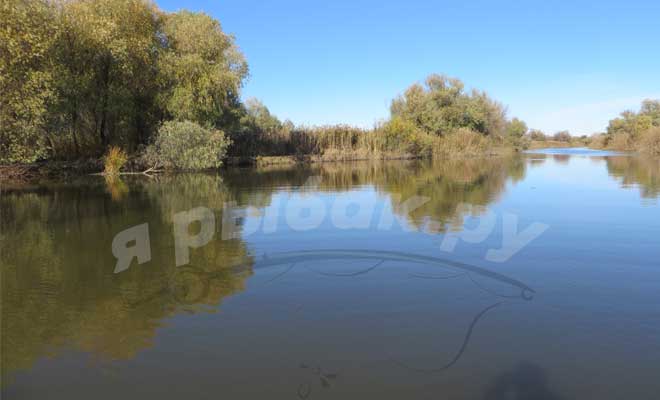
During early autumn freeze-up, pike should be looked for at the boundaries of ice and open water, placing bait at these points when fishing with spinning rods. The first ice pulls the predator onto the shallows, where small fish are still piled up. In the dead of winter, with oxygen deficiency, you need to look for fish near underwater springs and confluences of watercourses. At this time, the pike moves to significant depths. Closer to spring, when the ice begins to melt, the fish moves to areas of open water, regardless of the bottom topography and coastal vegetation.
What to catch pike with in the fall: how to choose bait

The main tool for autumn pike fishing is spinning. This is the time for the predator to feed, circling over schools of fish a couple of meters away and willingly going after any worthy prey. The choice of baits is extremely large, but there are three main players:
- Silicone baits such as vibrotail or twister
- Wobblers. Presented in a huge assortment, imitating live fish in their appearance
- Spoons. There are two types: oscillators and turntables. The choice of spinners in any fishing store is very large.
To select any specific bait, you need to take into account the season, the test of your spinning rod and the intended catch. You should not take a heavy spoon if the spinning test is intended for light baits. The size of the bait is important, but during autumn fishing you can catch a trophy specimen using a small spoon. Conversely, a small pike can go after a large bait, but the chance of such an outcome is much less. If the fishing condition is a body of water with a current, then you should give preference to large options. By concentrating on areas with holes and backwaters, a fisherman can get really impressive specimens, but in such cases a 10-centimeter bait, for example a wobbler, is needed.
A jig weighing eighteen grams or more will also work. You can use large oscillating spoons. The choice of color is determined by the current season and conditions of the reservoir. September fishing requires bright, often acidic baits, while in October it is necessary to take bait in more natural tones.
This striking difference comes from the degree of cooling of the reservoir and, as a result, an increase in the level of transparency. In clear October water, a bright red bait is more likely to scare away the fish than to attract it; a spinner, wobbler or silicone should be more consistent with the natural colors of the reservoir.
Silver and gold spoons are more suitable for fishing in early autumn. The red element on the bait always interests the pike. Even if you are fishing in the late autumn season, try using a wobbler that is partially red in color and the results will not be long in coming.
When fishing with a spinner, you can attach a brush of the desired color to the bait. October and November mean for most small fish gradual preparation for wintering and searching for wintering holes. A decrease in temperature drives them deeper and deeper, therefore, pike also need to be looked for at a depth, just above the habitats of its prey.
Where, when and what bait to use for fishing
In spinning fishing, absolutely all known baits of artificial origin are used. They fish using this method in open water, in reservoirs with and without current. In autumn, large-sized oscillating spoons and wobblers are used. Spring fishing is characterized by the use of silicone baits and rotating spinners. The use of wobblers is distinguished by the presence of noise chambers in their designs, and the average sizes of seven and nine centimeters are more optimal than large specimens in the fall. In the summer, poppers and spinerbaits perform well among spinning baits. Mugs and girders in open water are used from the end of July until freeze-up. Small roach, perch, crucian carp, gudgeon and loach are used as live bait. In November, you can set up bottom gear using dead fish, bleak or defrosted sprat.

The vertical trolling method also worked well at this time, especially on slopes into the depths. In winter, they catch fish at winter rates using live bait. It is especially effective to use live bait caught directly in a body of water, which is familiar to the predator’s diet; such a sample on the hook remains active for quite a long time. When pike bite at stakes, it is wise to start fishing with balancers and ratlins, using a winter spinning rod as a fishing rod. A predator can take them in different water horizons, therefore, you need to fish, without leaving one hole, the entire thickness, gradually raising the bait by one and a half, two meters, and so on until the ice.
Why doesn't pike bite?
There are times when all the fishing factors are on the angler’s side, but there are no bites, despite such luck in weather and time conditions. Therefore, you need to look for the reasons for failure in your own actions. Initially, you need to decide on promising places where there is a high probability of finding a predator. An important point in equipping the gear. Perhaps the excessive roughness of the installation alarms the pike and it is worth changing the leashes to thinner diameters and increasing their length.
Varying the baits to smaller ones, slower moving ones, and different colors can radically change the situation. When fishing with live bait, there is a reason to use a native fish from a local reservoir and experiment with its installation level relative to the bottom. When fishing is done from a boat using the trolling method, and when the pike is completely inactive, but there is confidence that a predator is present in the reservoir, an effective option is to walk at medium speed with a motor boat through shallow water thickets, in this way scaring the fish and provoking it to move. Often, after such actions, the results exceed even the wildest expectations.
Recommendations for successful fishing
Before leaving for the fishing area, carefully study its topography and structure. Nowadays, there are opportunities for absentee visits to any body of water, studying it from aerial photographs and analyzing reviews and reports of other fishermen. Don't neglect the possibilities for more elegant installation by using their fluorocarbon versions as leaders. Don't complicate the setup with unnecessary accessories.
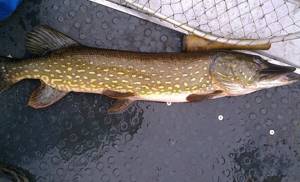
For example, when fishing with wobblers, do not use swivels, and having found a promising bait, it is always more effective to attach it to the main cord through a winding ring, rather than a massive clasp. When fishing from ice, if there are no bites for a couple of hours, do not be lazy to change your location, moving to other promising points. Try to remember the time intervals in certain places when pike are caught; analyzing the pattern of fish releases will help you plan your next fishing trip in the same place.
